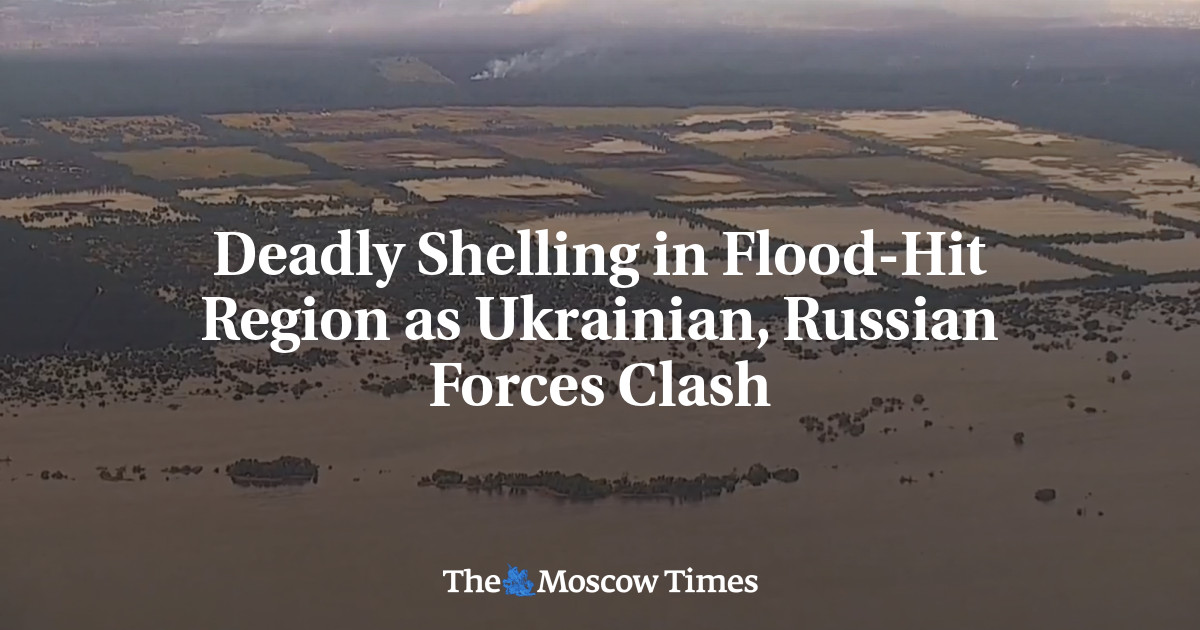
Ukraine and Russia accused each other of shelling rescuers and evacuees in the flood-hit Kherson region on Thursday as Moscow said its forces fought off a Ukrainian offensive in another part of the front line.
Emergency services were still racing to rescue people stranded by the flood-swollen waters of the Dnipro River, which have forced thousands to flee.
The destruction of a major Russian-held dam on the river on Tuesday left 600 square kilometers of the region under water.
Ukrainian President Volodymyr Zelensky visited the area on Thursday after floods inundated dozens of villages and parts of the regional capital, Kherson.
“I thank the rescuers and volunteers! I thank everyone involved in this work!” wrote Zelensky, who also visited survivors in hospital.
Shortly after the visit, Kyiv said Russian strikes in the center of Kherson and the surrounding region killed one person and injured 18 more, including emergency services staff.
Moscow-installed authorities on the other bank of the Dnipro River, which is controlled by Russian forces, said two evacuees were killed by Ukrainian shelling.
The death toll from the flooding reached six as the Moscow-backed administration of Nova Kakhovka, where the dam is located, said five people had died and 41 admitted in hospital.
Ukrainian police said one man had died in a riverside village in the neighboring Mykolaiv region, also affected by rising water levels.
U.S. President Joe Biden said Washington would provide long-term military support to Kyiv “as long as it takes,” while the Netherlands said it was sending rescue boats and water pumps.
Two-hour battle
In the neighboring Zaporizhzhia region, Russia said its forces had fought a two-hour battle with Ukrainian troops in the early hours of Thursday.
Russian Defense Minister Sergei Shoigu said the Ukrainian offensive involved 1,500 soldiers and 150 armored vehicles.
“The enemy was stopped and retreated after heavy losses,” he said.
Ukrainian officials have said their forces are ready for a long-expected counteroffensive but that there would be no formal announcement when it begins.
Ukrainian Deputy Defense Minister Ganna Maliar said only that Russia was conducting “defensive actions” near the town of Orikhiv in the Zaporizhzhia region.
In another development, Ukrainian authorities said water levels in a reservoir which had been created by the Kahovka dam had fallen “below the critical point of 12.7 meters (42 feet).”
This meant the reservoir was no longer able to supply households and the cooling ponds at the Zaporizhzhia nuclear power station, Europe’s largest.
However late Thursday the International Atomic Energy Agency (IAEA) said he nuclear plant was continuing to receive water from the reservoir after the dam was damaged.
The plant’s six reactors have been shut down but they still need cooling water to ensure there is no nuclear disaster.
Ukraine meanwhile called on Europe to double power supplies to two gigawatts.
‘Still people in there’
In the Kherson region, Ukrainian rescuers said they were venturing into Russian-controlled areas to save civilians despite the danger.
The area is the estuary of the Dnipro River and is dotted with islands and marshland where the precise location of the front line is sometimes unclear.
Ukrainian authorities have said 30 settlements were flooded, 10 of which lie in territory controlled by Russia on the Dnipro’s eastern bank.
Rescuers used boats and amphibious vehicles to pluck people from flooded areas. Some volunteers were also going out to rescue stranded animals and birds.
One woman, Tetiana Omelchenko, 65, said she had waited two days to be evacuated from her block of flats in Kherson and had to climb through a broken window to reach a rescue boat.
“In my building, the water has reached the third floor and there are still people in there,” she said.
‘Outrageous destruction’
In Brussels on Thursday, NATO Secretary General Jens Stoltenberg urged members of the alliance to speed up humanitarian assistance to Ukraine after the destruction of the dam.
The World Health Organization sounded a grim warning.
“The impact on the region’s water supply, sanitation systems and public health services cannot be underestimated,” WHO chief Tedros Adhanom Ghebreyesus told reporters.
“WHO has rushed in to support the authorities and health care workers in preventive measures against waterborne diseases and to improve disease surveillance,” he said.
Ukraine accuses Russia, whose forces control the dam area, of blowing up the dam, while Russia accuses Ukraine hitting it with artillery.
Ukrhydroenergo, the dam’s operator, said it was most likely mined from the inside.
The emergency service has warned the flood water has dislodged land mines that pose a threat to civilians.
The government has also sounded the alarm over the environmental impact, calling it “a crime of ecocide.”
A Greenpeace campaigner in Kyiv, Denys Tsutsaiev, warned that it could take a decade for some species to recover from the catastrophe and some may not recover at all.
According to the latest information, “at least 500 tons of oil was released due to the dam destruction,” the campaigner said, posing a threat to sea mammals and birds.